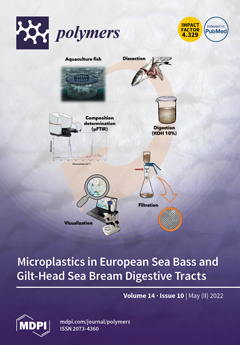In recent times, developments in polymer application properties have required the design of different polymer structures more than ever. Cross-linked polymers (CPs) could be considered a good candidate material for potential applications when used in conjunction with nanoparticles. Cross-linked polymethyl methacrylate nanocomposites are
[...] Read more.
In recent times, developments in polymer application properties have required the design of different polymer structures more than ever. Cross-linked polymers (CPs) could be considered a good candidate material for potential applications when used in conjunction with nanoparticles. Cross-linked polymethyl methacrylate nanocomposites are considered to be one of the most commonly polymeric adsorbents due to their varied and simple modification methods. A new class of C-PMMA/SnO
2(a–d) nanocomposites have been fabricated as surface-selective adsorbents of Cr (III) with a good yield and different loading of SnO
2 nanoparticles. The morphology, molecular structures, and thermal stability of the new cross-linked polymers were examined using a Scanning electron microscope (SEM), the Fourier Transform Infrared method (FTIR), X-ray diffraction (XRD), and Thermogravimetric Analysis (TGA). The adsorption study of C-PMMA/SnO
2 was investigated, and an efficient level of adsorption for Cr (III) cations was detected. To evaluate the potential for the new polymers to be used as adsorbents against Cr (III) ions, the contact time, the initial concentration of Cr (III), and the effects of pH were studied. The introduction of SnO
2 into the polymer network enhanced the efficiency of the adsorption of heavy metals. The C-PMMA/SnO
2 is highly efficient at removing Cr (III) ions in wastewater samples at pH 6 for one hour. The adsorption study demonstrated that the adsorption capacity of C-PMMA/SnO
2c for Cr (III) was 1.76 mg /g, and its adsorption isotherm agreed with the Langmuir adsorption model.
Full article






